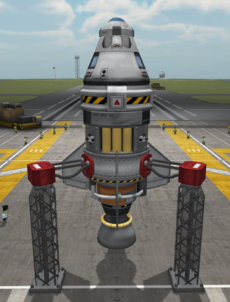Rocket/ko
A 로켓(rocket)은 수직으로 발사되는 기체(craft)를 일컫는 말입니다. 통상 로켓 엔진(rocket engine)을 사용하여 추진하며 주익(wing)이나 타익(winglet)을 사용한 양력을 이용하지 않습니다. 대기권(atmosphere)에서는 방향타 역할을 타익(control surface)으로 보조하게 됩니다. 로켓의 주목적은 우주로 날아가 궤도(orbit)에 진입하거나, 최소한 준궤도 비행을 하는 것입니다.
비행선(spaceplane)과 달리 로켓은 여러개의 비행단계(다단 로켓의 '단'을 의미; stage)를 가지고 있습니다. 연료를 소진한 빈 연료통이나 사용이 끝난 기타 부품들을 버림으로써 불필요한 무게를 줄여 로켓의 추진효율을 올리는 것이 다단로켓의 설계 목적입니다. With various stages, rockets can dump dry mass and get more efficient, while a spaceplane usually doesn't have stages. As they don't use lift to maintain altitude, the rocket engines need to counteract the gravity. To determine if the rocket can lift off, the thrust-to-weight ratio can be determined. If the ratio is above one, the thrust generated by the engines is higher than the gravitational force and thus the rocket will lift off. Because the engines drain fuel, the craft gets lighter so the ratio also increases with the flight.
Because rockets don't need lift surface, they work in every environment and don't need an atmosphere. But on the other hand, rocket engines with sufficient thrust are far more inefficient than jet engines with similar thrust.
Rockets are built in the Vehicle Assembly Building and then launched on the launch pad.
Start
The usual flight profile starts on the launch pad on Kerbin. Prior to liftoff, the jet engines, if any, need to be started to run at full throttle on liftoff. When the jet engines are running at full power, the liftoff can be initiated by activating the rocket engines and releasing any TT18-A Launch Stability Enhancers.
The rocket then starts to rise and continues so until reaching about 10 km. At this point a gravity turn is initiated by tilting in the desired direction. Depending on the targeted inclination, the direction of tilting might be different. For example, retrograde orbits, where the crafts rotates in the other direction than the body beneath it, the tilt would be to the West. With the gravity turn the craft starts to pick up horizontal velocity, which is crucial for a stable orbit. The engines continuing to accelerate the vessel to raise the apoapsis and periapsis out of the atmosphere.
As soon as the apoapsis and periapsis are outside the atmosphere, the craft won't fall back and has reached a so-called parking orbit. From this orbit it is possible to initiate orbital maneuvers like the Hohmann transfer, to change the orbital shape.

